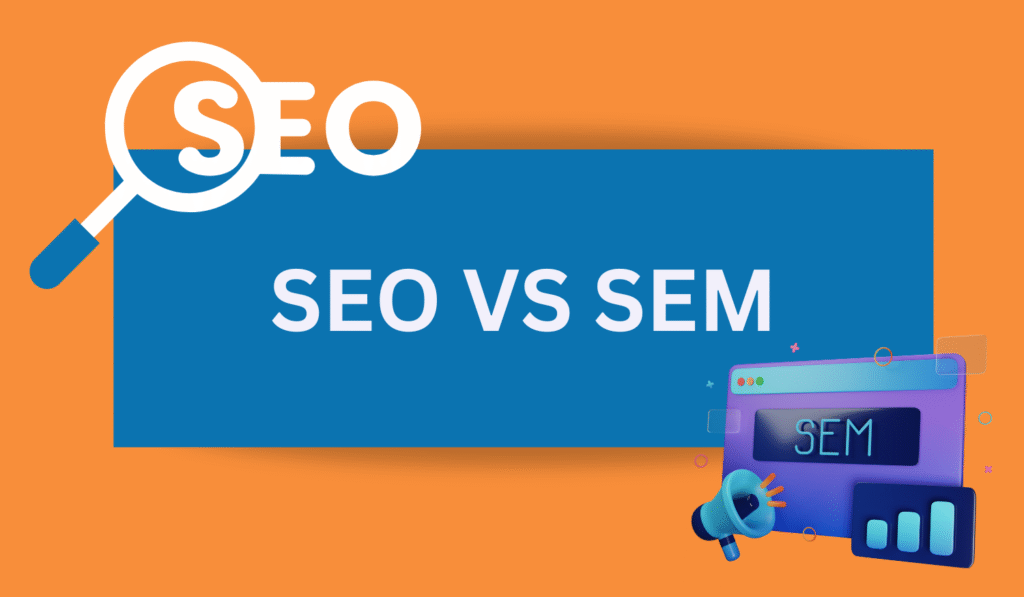Introduction
In the world of digital marketing, SEO(Search Engine Optimization) and SEM(Search Engine Marketing) are two critical strategies that drive website traffic, visibility, and business growth. While they may seem similar, SEO and SEM serve different purposes and use different approaches. Understanding the differences between SEO vs SEM is essential for marketers aiming to boost their online presence effectively.
What is SEO (Search Engine Optimization)?
SEO is the process of optimizing your website to rank organically on search engine results pages (SERPs). It involves on-page SEO, off-page SEO, and technical SEO to improve visibility without paid ads.
Key Components of SEO include:
- Keyword research
- Content Optimization
- Link building
- Mobile optimization
- Page speed and technical performance
Types of SEO
a. On-Page SEO : optimizing content, meta tags, images and internal links.
b. Off-Page SEO: earning backlinks and building domain authority.
c. Technical SEO: improving site speed, mobile-friendliness, indexing, and structured data.
Click here to learn more about types of SEO services.
What is SEM (Search Engine Marketing)?
SEM refers to paid strategies used to appear on search engine results, typically through platforms like Google Ads or Bing Ads. SEM includes PPC (Pay Per Click) advertising, where you bid on keywords to show you ads to users actively searching for your services.
Key SEM activities:
- Paid keyword targeting
- Campaign management
- Ad copywriting
SEM delivers instant visibility and quick results with measurable ROI.
SEO vs SEM : Differences
The difference between SEO and SEM in digital marketing are given below:
| Feature | SEO | SEM |
| Cost | Mostly free (organic) | Paid (per click or impression) |
| Time to Results | Long-term | Short-term/ Instant |
| Longevity | Sustained results | Ends when budget runs out |
| Click-Through Rate (CTR) | Higher for top organic listings | Lower but targeted |
| Trust Factor | Higher (users trust organic results) | Moderate (marked as ads) |
| Control | Less control over rankings | Full control over targeting |
| Goal | Build authority | Drive quick conversions |
Advantages and Disadvantages of SEO
The advantages and disadvantages of SEO are given below:
Advantages of SEO:
- Cost-effective in the long run
- Builds brand credibility
- Sustainable traffic
- Higher CTR on top rankings (when a web page is ranked higher, it tends to receive a larger percentage of clicks from users searching for relevant keywords)
Disadvantages of SEO:
- Takes time to show results
- Algorithm changes can affect performance
- Competitive keywords are hard to rank
Advantages and Disadvantages of SEM
The advantages and disadvantages of SEM are given below:
Advantages of SEM:
- Instants visibility
- Precise targeting
- Easy to measure and test
- Scalable and flexible
Disadvantages of SEM:
- Can be expensive
- Traffic stops when the budget ends
- Ad blindness from users
SEO vs SEM : Which One is Better for Your Business?
The answer depends on your business goals, budget, and timeline.
- Choose SEO if you want sustainable growth, long-term results, and have time to invest.
- Choose SEM if you need immediate traffic, are launching a new product, or want quick visibility.
When to Use SEO
Use SEO when:
- You aim to build long-term authority
- You’re targeting informational searches
- You want to reduce dependence on ads
- You’re focusing on content marketing
When to Use SEM
Use SEM when:
- You want instant traffic
- You’re testing a new market or product
- You’re running time-sensitive promotions
- Your SEO hasn’t kicked in yet
Combining SEO and SEM for Maximum Impact

The most successful digital marketing strategies integrate both SEO and SEM. While SEM gives you quick results, SEO ensures long-term sustainability.
How SEO and SEM Work Together
Here is the table that shows, how SEO and SEM Work together and give the maximum impact in marketing.
| Aspect | SEO | SEM | Combined Power |
| Visibility | Long-term organic rankings | Intermediate paid visibility | Dominate SERPs with dual presence |
| Keyword Strategy | Target high-value | Test keywords through paid ads | Use PPC data to inform SEO |
| A/B Testing | Slower to test and adjust | Rapid testing of headlines and CTAs | Apply SEM insights to SEO pages |
| Traffic Growth | Builds gradually, more sustainable | Instant but depends on budget | Complement each other across funnel stages |
| Credibility and Trust | Builds trust through organic ranking | Perceived as ads, less trust | SEO builds authority, SEM brings quick wins |
| Data Sharing | Limited feedback loops | Rich analytics from ads platforms | Unified data improves both channels |
Benefits of combining SEO and SEM:
- Keyword and content insights from SEM to improve SEO
- Double visibility on SERPs
- Better ROI with balanced strategy
SEO vs SEM examples
The SEO vs SEM examples are given below:
SEO Example (Organic Search)
Let us suppose, you write a blog post titled “10 Tips to Grow Indoor Plants” and optimize it for Google:
- Use relevant keywords like “indoor plant”.
- Add meta descriptions and alt text.
- Get backlinks from gardening blogs.
Result: Over time or Some time, your post ranks on page 1 of Google and gets traffic from people searching “how to grow indoor plants”.
SEM Example (Paid Search)
You run a Google Ads campaign targeting the keyword “buy indoor plants online”:
- You bid on that keyword.
- Your ad appears at the top of Google search results.
- When someone clicks your ad, you pay (e.g. Rs 159 per click).
Result: Immediate visibility and clicks from people ready to buy.
Conclusion
Understanding the difference between SEO and SEM is crucial for designing an effective online marketing plan. Whether you invest in organic SEO for long-term growth or SEM ads for instant traffic, aligning your strategy with your business goals is key.
It’s not about SEO vs SEM, it’s about using both strategically.
Frequently Asked Questions (FAQs)
Q1: Can I use SEO and SEM together?
A: Yes, combining SEO and SEM can improve your overall visibility and performance.
Q2: Which is more cost-effective: SEO or SEM?
A: SEO is more cost-effective in the long term, while SEM provides quick results at a cost.
Q3: How long does SEO take to show results?
A: Typically, SEO results appear within 3-6 months depending on competition and strategy.
Q4: Is SEM only Google Ads?
A: NO, SEM includes other platforms like BIng Ads, Yahoo Ads, and more.
Q5: What tools can help with SEO and SEM?
A: Popular tools include Google Analytics, Google Search Console, SEMrush, Ahrefs, Moz, and Google Ads.

